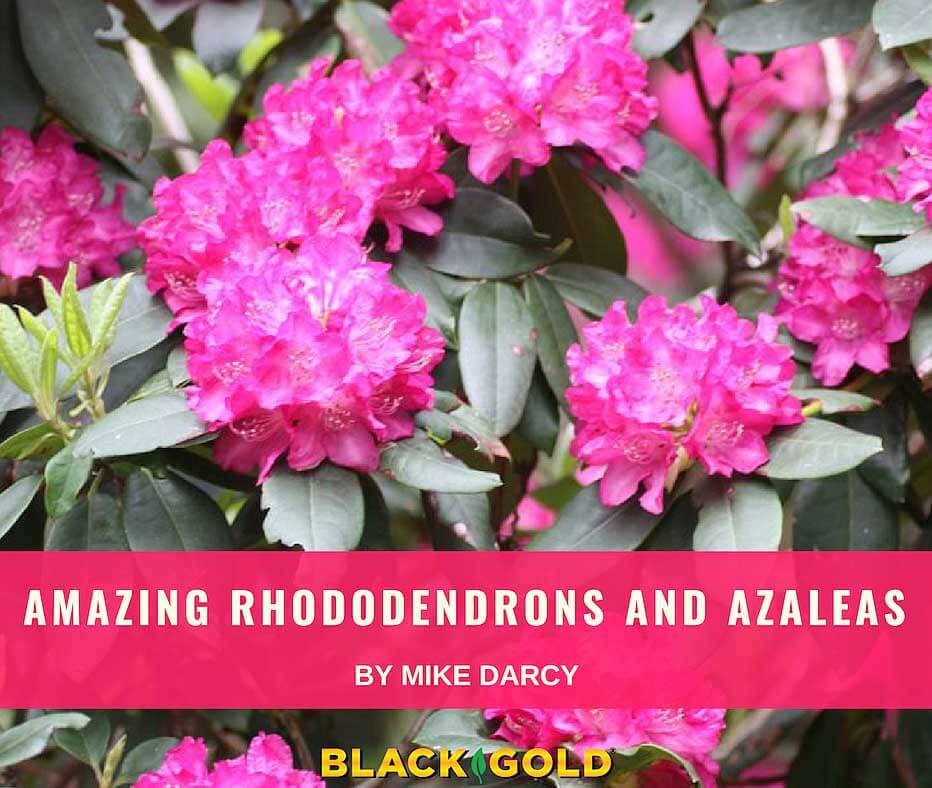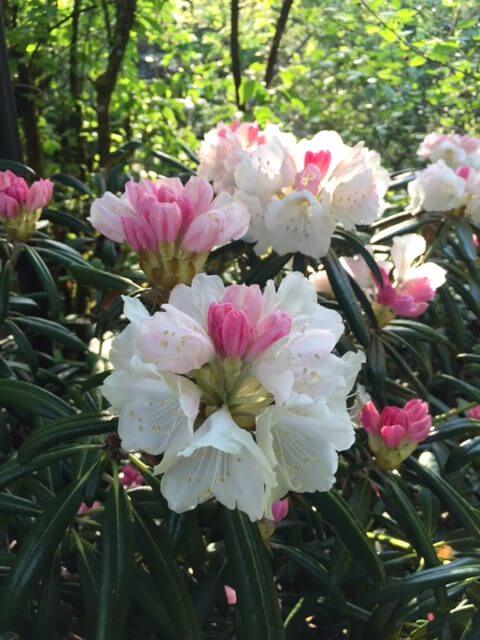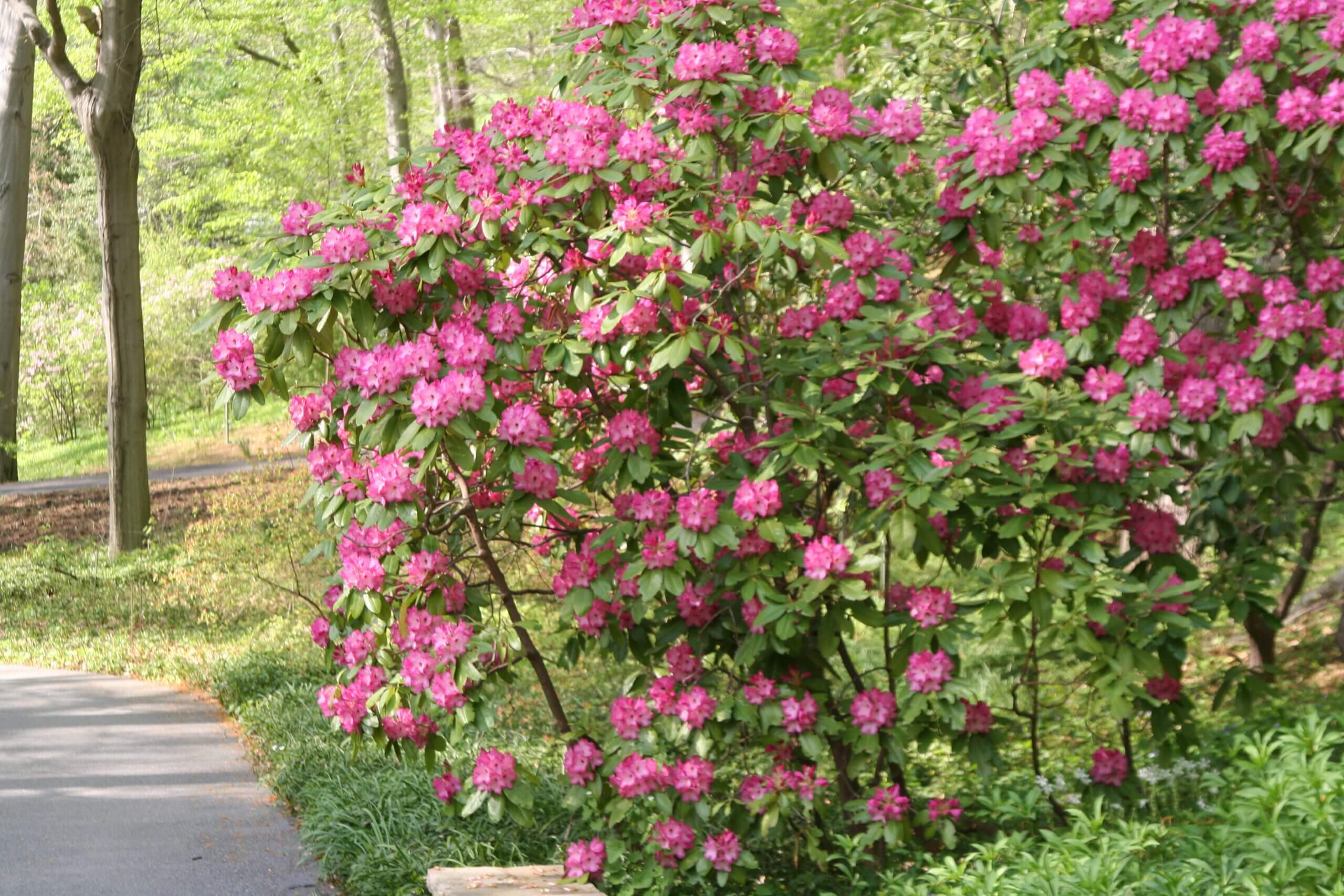
I cannot recall being in a Pacific Northwest garden that does not have rhododendrons and azaleas. Most gardens have many, and deservedly so. The hybrids can provide beautiful trusses of flowers throughout the spring and there are native species with smaller flowers but a very sweet fragrance. Our cool and moist climate is an ideal environment, and with a little extra care, they will thrive.
Rhododendron and Azalea Differences

While they can usually take full sun, my experience is that they seem to prefer some protection from the hot summer sun. Botanically, all azaleas are Rhododendron species, but there are several characteristics that distinguish these plants. 1. Rhododendrons usually have flowers in large clusters called “trusses”, and azaleas do not. 2. Rhododendron leaves tend to have scales, dots or dense hairs on their undersides while azaleas tend to have leaves with small hairs on the tops and bottoms. 3. Rhododendron flowers tend to have 10 or more floral stamens and azalea flowers tend to have 5. Plants can be both evergreen and deciduous (though more rhododendron are evergreen) and both like similar growing conditions.

As with many plants, there is a large diversity among rhododendrons and azaleas and some plants can tolerate more direct sun than others. When buying a plant, check the label as it should give a clue to the light requirement. Also, check the label for height as some plants can become small trees while others may stay as small shrubs. Bloom time is also variable and with a little research, one can have blooms from early spring, (February/March), and on through early summer. Peak bloom time for most plants would be May and the flower colors are as diverse as any group of plants that I can think of with shades of purple, white, yellow, orange, pink, and red. While most are solid colors, some can be bi-colored and others have speckles.
Rhododendron and Azalea Varieties
One of my favorite rhododendron varieties is Rhododendron yakushimanum ‘Yaku Angel’. It has wonderful white, felt-like new growth and soft brown hairs under the leaves called indumentum that feels like velvet to the touch. The flowers are light pink in bud and open to white. It is a beautiful shrub in the garden at any season, whether in bloom or not. The new rhododendron ‘Dark Lord’ is a very compact, burgundy-flowered variety that is also exceptionally beautiful and reliably cold hardy.

There are lots of great azaleas to choose from. One of the best for glowing spring color is the blazing orange-red-flowered ‘Fireball’. The popular azalea Bollywood™ is another much-sought variety that boasts cream and dark green variegated foliage in addition to bright red flowers. The classic azalea ‘Springtime’ is a more subdued cultivar with rich pink flowers that appear in mid spring.
Rhododendron and Azalea Culture
Both rhododendrons and azaleas like a soil that is slightly on the acid side, a 5-6 pH should be good. They need a constant supply of moisture, but good drainage is essential. Their roots should never be saturated.
In the natural environment, rhododendrons and azaleas often grow below tall trees. In these forested environments, the trees drop needles or leaves to create a natural organic layer. In a garden setting, these shrubs also appreciate good organic content in the soil. Black Gold Canadian Sphagnum Peat Moss is ideal to use as a soil amendment at the time of planting. In my garden, I also like to add Black Gold Garden Compost Blend as a spring garden top dressing to help conserve moisture during the summer. Once rhododendron and azaleas plants are established in a garden, they are relatively easy to maintain
 Most commonly, these shrubs set flower buds on the prior years’ wood. That means the buds for spring flowering plants form during the previous summer or fall. If you prune in late summer, you may be cutting off your flowers buds and not have any blooms in the spring. A good rule is to prune right after flowering.
Most commonly, these shrubs set flower buds on the prior years’ wood. That means the buds for spring flowering plants form during the previous summer or fall. If you prune in late summer, you may be cutting off your flowers buds and not have any blooms in the spring. A good rule is to prune right after flowering.
In addition to their spectacular flowers, some evergreen rhododendrons have a material on the new leaves and undersides of the leaves, called indumentum. It is a wooly or hairy covering that is often a beautiful copper color and provides color all year.
Many cities in the Pacific Northwest have rhododendron gardens, which are ideal for visitors to learn how they perform in the garden and in the elements. Rhododendron gardens can also give gardeners ideas on companion plants that look and perform well with these shrubs. I would suggest visiting one of these rhododendron gardens as it may open your eyes to many rhodies you did not even know existed!

